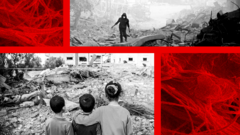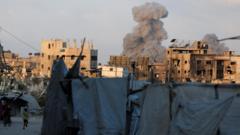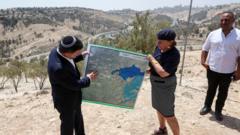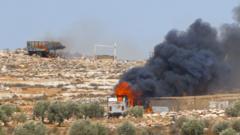With over 2.3 million tons of rubble potentially laced with asbestos, experts warn of a looming public health crisis in the densely populated region.
Toxic Legacy: The Asbestos Threat in Gaza's Rubble

Toxic Legacy: The Asbestos Threat in Gaza's Rubble
Asbestos contamination in Gaza raises severe long-term health concerns for residents amidst ongoing military conflict.
The recent military conflict in Gaza has led to a hidden health crisis: the significant risk of asbestos exposure in the rubble left behind. As described by Professor Bill Cookson from the National Centre for Mesothelioma Research, the environment is now "very, very toxic," and the impact of asbestos, a substance linked to lung cancer and asbestosis, will unfold over decades. The United Nations Environment Programme (UNEP) estimates that vast amounts of asbestos-containing materials remain in Gaza, particularly in the roofs of older buildings, with 2.3 million tons of rubble contaminated.
Although used in construction long ago, asbestos has been banned in many parts of the world due to its health risks. Its fibers, invisible to the naked eye, can cause severe lung diseases after even minimal exposure. Dr. Ryan Hoy notes the dangers of inhaling these tiny particles in the region, further complicated by Gaza's high population density of approximately 2.1 million people across a mere 141 square miles.
The ongoing violence and humanitarian crisis have overshadowed awareness of these health threats. Chiara Lodi, a medical co-ordinator with Medical Aid for Palestinians, emphasized that residents are currently more focused on immediate survival rather than the long-term dangers posed by asbestos and dust inhalation. As many residents remain unaware of the hazardous nature of the debris, the situation is dire.
Past conflicts have demonstrated asbestos's presence in Gaza's rubble, and the UN's previous assessments have confirmed its alarming concentrations across various building types. Legislative measures against asbestos vary globally; some countries continue to allow limited use, while others have fully banned it.
The health implications extend beyond lung cancer to include additional respiratory conditions, exacerbated by the ongoing conflict. Historical data from incidents like the 9/11 attacks reveal how respiratory conditions can emerge from exposure to toxic dust clouds, stressing the need for careful clean-up measures in Gaza to avoid endangering public health further.
The reconstruction of Gaza will require extensive management of hazardous materials, with estimates suggesting it could take 21 years and cost up to $1.2 billion. As the region grapples with immediate crises, the health risks posed by asbestos remain a buried threat, which could inflict lasting harm on those exposed to the contaminated rubble.
Although used in construction long ago, asbestos has been banned in many parts of the world due to its health risks. Its fibers, invisible to the naked eye, can cause severe lung diseases after even minimal exposure. Dr. Ryan Hoy notes the dangers of inhaling these tiny particles in the region, further complicated by Gaza's high population density of approximately 2.1 million people across a mere 141 square miles.
The ongoing violence and humanitarian crisis have overshadowed awareness of these health threats. Chiara Lodi, a medical co-ordinator with Medical Aid for Palestinians, emphasized that residents are currently more focused on immediate survival rather than the long-term dangers posed by asbestos and dust inhalation. As many residents remain unaware of the hazardous nature of the debris, the situation is dire.
Past conflicts have demonstrated asbestos's presence in Gaza's rubble, and the UN's previous assessments have confirmed its alarming concentrations across various building types. Legislative measures against asbestos vary globally; some countries continue to allow limited use, while others have fully banned it.
The health implications extend beyond lung cancer to include additional respiratory conditions, exacerbated by the ongoing conflict. Historical data from incidents like the 9/11 attacks reveal how respiratory conditions can emerge from exposure to toxic dust clouds, stressing the need for careful clean-up measures in Gaza to avoid endangering public health further.
The reconstruction of Gaza will require extensive management of hazardous materials, with estimates suggesting it could take 21 years and cost up to $1.2 billion. As the region grapples with immediate crises, the health risks posed by asbestos remain a buried threat, which could inflict lasting harm on those exposed to the contaminated rubble.





















